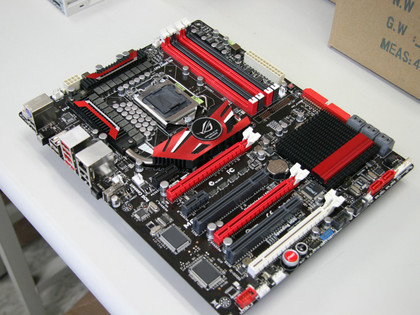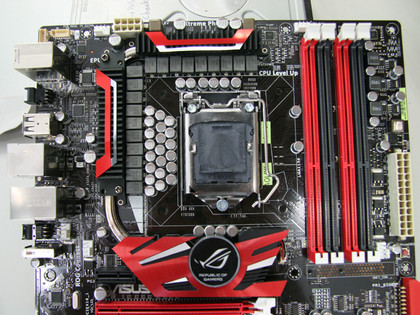In pictures: Asus Maximus III Formula
We've just been leaked some exclusive photos of Asus' new Maximus III Formula motherboard, that shows that the company may be toning down the excesses of its previous Republic of Gamers boards with the recession in full swing.
Unlike its predecessor, the new board only has one Ethernet port and, unlike the original Maximus Formula, it won't be based on a top-end X-series chipset either.
Instead, it's based on Intel's forthcoming P55 chipset, the board comes with four DIMM slots for dual-channel memory, but it also has three PCI-E graphics slots.
Asus hasn't revealed which multi-graphics standards will be supported, but the top two PCI-E graphics slots are sensibly spaced, so you can install two dual-slot graphics cards and still use the PCI slot in the middle.

TRYING OUT SETTINGS: The Start and Reset buttons will make it easy to experiment with settings on the workbench

BACKPLANE: Unlike the Maximus Formula II, the new Maximus Formula only has one Ethernet port
Similarly, there's plenty of room around the CPU to install a large heatsink, while the voltage regulator modules (VRMs) are cooled by unobtrusive, flat heatsinks that are connected to a fan by a heatpipe system. In addition to the PCI-E graphics slots, the board also has two PCI slots and one single-lane PCI-E slot. We assume that the latter will accommodate an Asus sound card like the Maximus Formula II, particularly as there are no audio jacks on the back.
Sign up for breaking news, reviews, opinion, top tech deals, and more.

DUAL SLOT: You can easily install two dual-slot graphics cards and still use the PCI slot in the middle
On the back you'll find a PS/2 port, an e-SATA connector and a FireWire port, as well as a Clear CMOS button and nine USB ports. However, one of these is positioned at a different angle, which leads us to believe that it might be used to connect an external overclocking device. Meanwhile, a Start and Reset button on the board will enable overclockers to quickly experiment with the board on the workbench.

LARGE COOLER: There's plenty of room around the socket to install a large CPU cooler, and the VRM heatsinks shouldn't get in the way either

HEATPIPES: The VRM coolers are connected to a fan via a heatpipe system

LARGE HEATSINK: A huge, flat heatsink sits at the bottom of the board

FOUR DIMM SLOTS: The board comes with the standard allocation of four DIMM slots for two banks of dual-channel memory